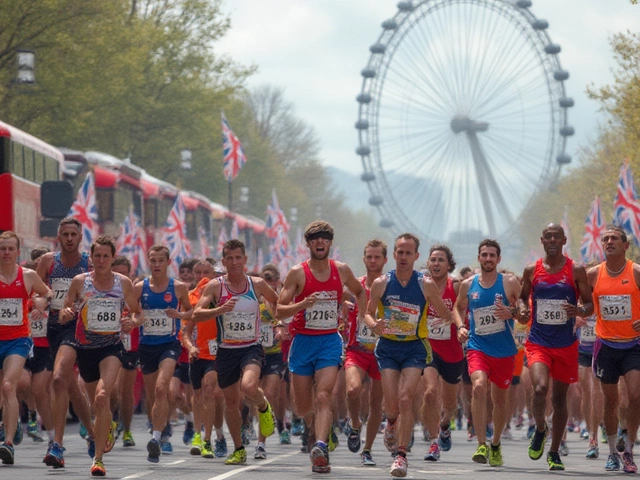Have you ever noticed how marathon runners possess lean, toned legs rather than the bulky muscles often associated with sprinting or bodybuilding? This intriguing observation is linked closely to the kind of training and physiological adaptations marathoners undergo.
The focus on endurance means their bodies are optimized for lengthy periods of activity, favouring efficiency and aerobic capacity over sheer muscle power. As their workouts concentrate on building stamina and performance over extended distances, the legs adapt accordingly to meet these demands, showcasing a different kind of strength.
Diving into the world of marathon training uncovers various factors like workout types, nutrition, and body physiology that explain this unique athletic build. By examining these factors, we gain insights into how marathon runners achieve their svelte physique and the techniques they rely on to maintain peak performance throughout grueling races.
- The Physiology of Marathon Running
- Cardio vs. Weight Training
- Nutrition's Role in Muscle Development
- The Importance of Aerobic Capacity
- Misconceptions About Muscle Growth
- Tips for Runners Seeking Bigger Legs
The Physiology of Marathon Running
Diving into the physiology behind marathon running offers fascinating insights into why these athletes develop such unique physiques. At the core, marathoners prioritize aerobic respiration, which is a slower energy-releasing process primarily using oxygen to convert stored nutrients into energy. This differs fundamentally from anaerobic respiration, which is more about quick bursts of power seen in sprinters. When the body runs on aerobic engines, it encourages the steady burning of fats and carbohydrates, rather than rapidly depleting muscle glycogen reserves. This process supports endurance rather than muscle hypertrophy. It's this reliance on steady aerobic training that keeps a marathon runner’s legs from becoming bulky.
Interestingly, marathon training focuses on not just building muscle strength, but enhancing the muscles' ability to endure prolonged stress. Muscles used in marathon running, particularly in the lower body, adapt by increasing the density of mitochondria—the tiny powerhouses in cells that produce energy. Also, increased capillary networks deliver more oxygen to the muscles, further aiding in endurance. This perfect combination isn’t conducive to muscle growth in size, yet it’s optimal for prolonged activity.
Moreover, marathon runners generally have a higher percentage of slow-twitch muscle fibers compared to fast-twitch fibers. Slow-twitch fibers, known for their endurance capacity, further the capacity to run long distances without tiring quickly. These fibers are smaller in diameter compared to fast-twitch fibers that grow larger with weight training. An interesting fact is the body's adaptation mainly turns on slow-twitch fibers, while giving just the necessary engagement to fast-twitch components, ensuring endurance over raw power.
This physically demanding sport also means that muscle size is a secondary aspect for marathoners. Physiologically, larger muscles consume more oxygen, which translates directly to needing more energy and potentially becoming 'oxygen-starved' earlier in a race. Hence, the aim is to maintain lean muscle mass that not only supports the body but also optimizes every ounce of oxygen consumption. As elite marathoner Dr. Jack Daniels has noted, "Improving running economy is a key to better performance."
"Higher oxygen efficiency and increasing VO2 max is a hallmark of well-conditioned marathon runners," says scientific studies, highlighting how physiological changes are prioritized over muscle bulk.
So, while other athletes may strive to build muscle for explosive power, marathoners embrace physiology that prioritizes efficiency and the kind of strength that comes not from size, but endurance. This unique adaptation makes their bodies perfect machines for marathon races, with legs sculpted for efficiency rather than pure strength. They strategically adapt their physiology to the sport's specific demands, creating a leaner appearance without sacrificing their remarkable ability to keep running mile after mile.
Cardio vs. Weight Training
Marathon running shapes uniquely agile athletes due to the particular balance between cardio and weight training. Understanding the distinctions between these two exercise regimes and how they cater to different athletic needs is crucial for anyone entering the realm of marathon running. Cardio exercises, which include running, cycling, and swimming, prioritize cardiovascular endurance. These workouts elevate your heart rate and are designed to improve lung capacity, circulation, and stamina over time. In this context, your body becomes adept at efficiently using oxygen, which is vital for completing a marathon.
On the flip side, weight training focuses on building muscle mass and strength through resistance exercises. Here, the goal is muscle hypertrophy, achieved by lifting weights that overload the muscles, breaking them down so they rebuild stronger and larger. This is what contributes to that bulkier appearance in athletes like sprinters or bodybuilders, whom you might see in a gym hoisting heavy dumbbells. These athletes often engage in high-intensity, short-duration activities that prioritize explosive power rather than endurance.
For a marathoner, the emphasis is not on mass, but on function. Building strength is part of the equation, but not at the expense of speed and efficiency. Marathon runners often include some form of strength training, but it is balanced with ample aerobic workouts to ensure there isn't an overgrowth of muscular size. “Our goal is to optimize strength for running efficiency, not to build excess muscle that could weigh us down during a race,” a seasoned marathon coach, John Anderson, once said during an interview about endurance training strategies. This insight highlights how weight training is adapted for endurance-focused goals without compromising the streamlined physique that is quintessential for a marathon runner.
Moreover, the priorities of different energy systems are significant when discussing these exercise forms. Cardiovascular conditioning predominantly engages the aerobic energy system, using oxygen for sustained energy release over long periods. This is ideal for distances like a marathon, as the body shifts into a state where fat is efficiently used as a fuel source, preserving muscle glycogen. Weight training, however, engages the anaerobic systems, relying on quick bursts of energy often fueled by stored creatine phosphate and glycogen. Over-straining the anaerobic system in a marathon scenario can lead to muscle fatigue, which is a key reason marathon runners weigh their regimen towards maintaining aerobic efficiency.
In summary, while both forms of exercise are critical for a runner, striking the right balance of cardio and weight training equips marathoners with the strength, endurance, and lean muscle composition essential for long-distance success without veering into the territory of excessive bulk that does not support their demands. Incorporating more repetitions with lower weights, enhancing endurance without hypertrophying the muscle, is how marathoners maintain distance prowess.
Nutrition's Role in Muscle Development
The journey of muscle growth and achieving the desired physique goes hand in hand with nutrition. When it comes to marathon runners, the focus shifts towards a unique dietary regimen meant to fuel long runs rather than bulking up muscle mass. A balanced diet plays a crucial role in providing necessary energy and preventing muscle breakdown, which is vital for anyone, especially those focused on *marathon running*. Proteins, carbohydrates, and fats each contribute in their distinct ways to this finely tuned engine that every runner aspires to develop.
Strategically incorporating protein into the diet helps in muscle repair and recovery. While many athletes aim for high protein intake to grow muscles, this shifts for endurance runners. They aim for sufficient protein to aid recovery post-long run, keeping their muscles lean and efficient. Experts often suggest about 1.2 to 1.6 grams of protein per kilogram of body weight as a guideline for endurance athletes. This intake, however, doesn’t mean substantial muscle gains but rather preserves current muscle mass, providing ample support for repeated physical exertion.
Carbohydrates emerge as the real hero for marathon enthusiasts. They are stored as glycogen in muscles and the liver, providing the essential energy needed during a marathon. Runners need to keep these stores replenished, as glycogen is the most readily available fuel during those exhaustive miles. Evidence has shown that an appropriate carbohydrate intake between 5 to 10 grams per kilogram of body weight daily can maintain these energy levels.
Moreover, essential fats should not be neglected. They contribute indirectly by aiding hormone regulation and supporting vitamin absorption, crucial elements in sustaining training regimens. While fats are not the primary energy source during running, the inclusion of healthy fats like omega-3s enhances the overall performance and recovery of *endurance training* athletes.
Many champion runners follow a meticulously planned diet that includes whole foods, lean proteins, healthy fats, and complex carbohydrates.
"Food is fuel. You can't expect to go far on an empty tank," notes a famous coach from the Boston Athletic Association. This insight reflects their strategy to prevent gut issues and ensure energy supply.One mustn't ignore the timing of meals. Consuming a pre-race meal rich in carbohydrates hours before a run maximizes glycogen stores, while a combo of protein and carbs immediately after helps in the recovery process.
Ultimately, while muscle building remains less of a priority for marathoners, nutrition is undeniably pivotal to their success. It is the quiet partner that makes sure the muscles perform at their best race after race without adding unnecessary bulk. This nuanced understanding of diet as a part of the broader marathon training strategy allows runners to maintain the lean, efficient build required to succeed in *endurance training* endeavors.

The Importance of Aerobic Capacity
Aerobic capacity is at the core of why marathon runners exhibit such remarkable endurance and, ultimately, why their legs remain lean rather than becoming bulked up. For marathoners, training is aimed at maximizing the efficiency with which their bodies utilize oxygen during prolonged periods of running. This capability is often termed as VO2 max, a measure of the maximum amount of oxygen an individual can use during intense exercise. When athletes talk about building aerobic capacity, they refer to extending this threshold, ensuring they can maintain higher intensities for longer durations without succumbing to fatigue.
How does boosting aerobic capacity translate to performance improvements? Well, as you enhance your VO2 max through targeted training, your body becomes more adept at shuttling blood and oxygen to your muscles. This, in turn, boosts their endurance and allows them to work tirelessly over the extensive miles of a marathon. Unlike sprinting, which calls for short bursts of speed and powerful, explosive actions that bulk up muscles, marathon running demands a sustained energy output over time. Runners engage in a regimen focusing predominantly on building stamina rather than muscle mass, resulting in the unique physique admired by many.
Moreover, the efficiency brought about by such training means marathoners can dispose of waste products produced during extensive runs rapidly. As they heighten their aerobic capabilities, runners become adept at keeping lactate levels under control, making it possible to stave off the dreaded 'hitting the wall' phenomenon associated with muscle fatigue. Intriguingly, aerobic capacity isn’t just a single metric but a symphony of bodily functions working in harmony — the heart pumping with precision, lungs expanding and contracting effortlessly, and muscles firing almost endlessly. This orchestrated performance allows marathoners to tick off mile after mile methodically.
"Endurance is not just about the legs; it’s a mental and physiological relationship,” notes sports scientist Dr. Stuart Holt. “Building aerobic capacity means pushing both body and mind to adapt and optimize."
When contemplating how to increase their aerobic capacity, marathon runners often incorporate specific techniques into their training schedules. These include long steady runs, high-intensity intervals, and tempo runs, each serving a unique purpose in broadening the aerobic window. A balanced mix of these workout styles enables athletes to tap into various energy systems crucial for developing sustenance over long races. Importantly, such training regimes are adaptable, aiding runners at different levels, from novices attempting their first marathon to seasoned athletes eyeing a new personal best.
By prioritizing aerobic fitness, runners not only bolster their competitive edge but also obtain numerous health benefits that come with sustained cardiovascular activity. As the heart gets stronger, the risks for heart-related ailments diminish significantly. As lungs become more efficient, oxygen uptake is optimized to the fullest, benefiting overall respiratory health. The link between aerobic capacity and marathon running is a testament to how specializing in endurance can shape not just performance on the track but the holistic health of a runner.
Misconceptions About Muscle Growth
Many people hold the belief that to gain muscle mass, intense weightlifting is the only path. This leads to the notion that anyone aiming to enhance their leg muscles must spend countless hours in the gym hoisting heavy weights. However, this is a simplistic view. Muscle growth, or hypertrophy, depends on several factors, not just the weights you lift. For runners, especially marathon enthusiasts, this means that muscle development takes on a different form. The emphasis is on endurance training, and this caters to enhancing muscle efficiency rather than size. This kind of training focuses on slow-twitch muscle fibers that bolster stamina and support long-distance running performance, rather than sparking hypertrophy, which chases after the development of fast-twitch fibers responsible for explosive strength and bulk.
The idea that aerobics or cardio workouts are more likely to melt away muscle is another myth. While it is true that excessive cardio might impede muscle gains, marathoners incorporate these routines specifically to boost cardiovascular endurance and muscle resilience. The type of muscle built through endurancetraining contributes to lean and toned legs, which help marathoners swiftly clock marathon times without the extra weight.
Interestingly, some individuals believe nutrition plays a secondary role compared to physical workout when it comes to muscle growth. In reality, a balanced diet is crucial. Protein is indeed vital for muscle repair and growth, but striking a balance that suits one's specific physical activity level holds significance. For long-distance runners, tailoring diets to support prolonged energy exertion and recovery is as critical as the training itself. Dr. Robert Wolfe, a professor at the University of Arkansas, states,
"Muscle growth depends on a positive protein balance, which means synthesizing more protein than you are breaking down."This highlights why runners, while focusing on aerobic activity, must adjust their diet to ensure they are repairing and fueling their muscles adequately.
Additionally, some argue that marathoners avoid strength training altogether, but that’s not entirely accurate either. Incorporating strength exercises is necessary to prevent injury and aid in maintaining an efficient running form. However, the way marathon runners utilize their strength workouts aims more toward function and injury resistance rather than purely growing the muscle size. For instance, runner-friendly strength training includes squats and lunges that mimic the running movement and fortify the stability of muscles used during lengthy runs.
To dispel these myths, it's vital to acknowledge a marathon runner's unique physical requirements and training atmosphere. The fusion of aerobic and strength training, coupled with tailored nutrition, creates a balance that supports their sport without leading to substantial leg muscle bulking. Therefore, understanding these nuances enables one to appreciate the intricate dance between muscle growth and endurance required for marathon success.
Tips for Runners Seeking Bigger Legs
If you're a marathon runner eyeing a more muscular leg profile, it might seem challenging given the nature of endurance training. Building substantial leg muscles isn't impossible, but requires strategic adjustments to your routine. The primary obstacle is that traditional marathon training prioritizes stamina, which can limit muscle size increase. To achieve leg growth while maintaining your running prowess, integrating strength workouts aimed at hypertrophy is pivotal.
Introduce weight training sessions several times a week focusing on exercises that target the leg muscles specifically. Squats, lunges, and deadlifts are fundamental exercises to foster growth in the quadriceps, hamstrings, and calves. During these sessions, aim for a higher weight with lower repetitions. This approach contradicts the high-rep, low-weight norm, steering muscle fibers toward growth. Integrate unilateral exercises like single-leg squats and step-ups to enhance muscle balance and strength asymmetries, which are common in marathoners.
Nutrition plays a significant role in muscle development as well. Consuming a diet rich in protein can supply your body with the essential amino acids necessary for muscle repair and growth. Lean meats, legumes, dairy, and protein supplements can enhance your caloric intake, supporting both energy expenditure from running and muscle rebuilding efforts. Hydration also features prominently since muscles are primarily composed of water, proper hydration assists in maintaining their form and function. A sometimes overlooked aspect is the role of rest; muscles grow not during the workout but as they recover. Ensuring adequate sleep each night will allow your body to repair and grow those hard-earned muscles.
Changing the training focus from pure endurance to a hybrid approach might challenge your body's accustomed regimen, so it’s paramount to pace these alterations. Gradually incorporating mixed-training structures can help in preventing fatigue and injury while giving your body time to adapt. Engaging exercises like hill sprints or varied pace runs can supplement the leg-blasting benefits of weight training without sacrificing the cardiovascular conditioning required for marathon success. One effective strategy is periodization: structuring your training into blocks that prioritize different goals, such as dedicating a month solely to strength before returning to endurance.
Monitoring progress is crucial, and keeping a diary or journal can provide amazing motivational boosts as you begin to witness changes. Take note of your weights, reps, and dietary intake. Keeping a log not only helps you see where improvements are being made but can highlight trends or areas for further focus. Consulting a trainer or coach who understands the balance between increasing leg mass and maintaining marathon endurance can further illuminate your path.
“Muscles are not built overnight; consistent dedication to both diet and exercise are the true keys to achieving the physique you desire.” — Charles Glass, renowned bodybuilding coach
The sweet spot lies where endurance and strength intersect, offering runners the unique blend of distance capability and the muscular legs desired. By weaving together a routine rich with running and muscle growth methods, marathoners can sculpt a physique that’s both strong and enduring. Remember, every runner's body responds differently, and it's crucial to stay flexible, adapting your strategy to fit your individual needs.






